|
 Grant
Green (St. Louis, Missouri 6 giugno 1931 - New York 31 gennaio 1979) was one
of the most unique and influential jazz guitarists in the 1960s. His playing had
an impact on younger guitarists like George Benson and Pat Martino
who were just emerging on the jazz scene in
1965. Grant
Green (St. Louis, Missouri 6 giugno 1931 - New York 31 gennaio 1979) was one
of the most unique and influential jazz guitarists in the 1960s. His playing had
an impact on younger guitarists like George Benson and Pat Martino
who were just emerging on the jazz scene in
1965.
Green's guitar sound is instantly recognizable - his clear tone has a
slightly trebly cutting-edge, balanced by a warm and mellow mid-range. Depending
on the dynamics of the song, he could dig into his lines with a fiery
soulfulness, or spin off a series of sweet, laid-back melodic inventions
accompanied by a lengthy sustain, and punctuated by short, incisive blues riffs.
He could swing with driving intensity, strut like a New Orleans marching band,
play it cool like a late night breeze, turn up the heat again with a spicy
samba, negotiate post-bop, modern, modal harmony alongside Coltrane's rhythm
section, play the blues with a Sunday morning Gospel beat, and lay down a groove
with the funky soulfulness of James Brown.
Most of Grant Green's recordings as a leader or sideman were for the Blue
Note label, who featured him in a wide variety of groups with famous
heavyweights Hank Mobley, Herbie Hancock,
Lee Morgan, Wayne Shorter, Joe Henderson, Bobby Hutcherson,
McCoy Tyner, Art Blakey, Elvin Jones, Lou Donaldson,
Sonny Clark, Ike Quebec, Stanley Turrentine, Booker Ervin,
Horace Parlan, Paul Chambers, Wynton Kelly, and Billy Higgins
just to name a few! The classic Blue Note dates were primarily horns and
rhythm section. Green and Kenny Burrell were among the only guitarists to
capture that Blue Note "sound", and Green's hard bop capabilities greatly
contributed to his success.
 Green's
signature sound came from his recordings with organ players - giants like Larry Young, Don Patterson, Jimmy Smith,
and Jack McDuff, along
with Baby Face Willette,
John Patton, Sam Lazar, and Gloria Coleman. The organ
trio style of jazz, (guitar/organ/drums with saxophone making it a quartet), was
popular in the early sixties, and by 1965 it practically became a necessity as
jazz was forced to compete with the rising popularity of Rock music. At that
time, a jazz guitarist could have steady work playing six nights a week with an
organ group, and records sold well because people could party and dance to those
grooves. Green's background as a blues guitarist made him the perfect choice for
these settings, yet nothing compares to the reflective, modern jazz sound of
Grant Green and Larry Young, all of whose recordings together are among
the finest examples of this genre. Green's
signature sound came from his recordings with organ players - giants like Larry Young, Don Patterson, Jimmy Smith,
and Jack McDuff, along
with Baby Face Willette,
John Patton, Sam Lazar, and Gloria Coleman. The organ
trio style of jazz, (guitar/organ/drums with saxophone making it a quartet), was
popular in the early sixties, and by 1965 it practically became a necessity as
jazz was forced to compete with the rising popularity of Rock music. At that
time, a jazz guitarist could have steady work playing six nights a week with an
organ group, and records sold well because people could party and dance to those
grooves. Green's background as a blues guitarist made him the perfect choice for
these settings, yet nothing compares to the reflective, modern jazz sound of
Grant Green and Larry Young, all of whose recordings together are among
the finest examples of this genre.
Not just Grant Green and
Kenny Burrell, but also Wes Montgomery, George Benson,
Pat Martino, Eddie McFadden, even Jim Hall, and Joe
Pass were part of this trend as they all recorded with organ players.
Guitarist John Abercrombie played on a
1968
Johnny "Hammond" Smith
record titled "Nasty",
on Prestige. Abercrombie was deep into Grant Green and Pat Martino, whose
influences are evident in his playing at that time.
Guitarist John
Scofield was a student at Berklee in the early
70's
and recalls hearing Green play at Connelly's in Boston,
"At that time speed was everything
and the main guys on guitar were George Benson, Pat Martino, Tal Farlow and John
McLaughlin. Grant played everything as if it were slowed down. It was only later
that I realized that he swung hard. He had unstoppable swing."
(from the liner notes to
Grant Green's "First
Session" Blue Note
27548).
The stylistic influence
of Grant Green is just as strong today. A revival of the 60's organ sound took
off in the 1990's and contributed to the success of new guitarists such as
Peter Bernstein, while both Benson and Martino are returning
to their "roots" - Benson reuniting with organist Lonnie Smith and Martino
teaming up Joey DeFrancesco.
 His
main guitar, featured on his early 60's recodings, was a Gibson ES-330. A
thin-line, hollow body electric guitar with single coil P-90 pickups, the 330 is
similar to a 335 minus the block of wood in the middle of the body that served
to eliminate feedback. The amplifier on this recording has a nice vintage tube
sound. While impossible to say exactly which amp it was, recording studios
sometimes had a Fender Champ, Princeton, or even a Deluxe.
He also used a Gibson amplifier and a Fender Twin among other choices. His
main guitar, featured on his early 60's recodings, was a Gibson ES-330. A
thin-line, hollow body electric guitar with single coil P-90 pickups, the 330 is
similar to a 335 minus the block of wood in the middle of the body that served
to eliminate feedback. The amplifier on this recording has a nice vintage tube
sound. While impossible to say exactly which amp it was, recording studios
sometimes had a Fender Champ, Princeton, or even a Deluxe.
He also used a Gibson amplifier and a Fender Twin among other choices.
Commenting about his own playing, Green said,
"I don't listen to guitar players
much - just horn players. I used to sit up all night copying Charlie Parker's
solos note for note." (-
from the liner notes to "Grant's
First Stand", Blue Note
LP). If Grant sounds more like a horn player than a guitar player, it's because
of his almost exclusive use of single - note lines in his solos as opposed to
chordal styles used by Kenny Burrell and Wes Montgomery. He cited
his main guitar influence as being Charlie Christian (did anyone play
jazz guitar in the 1950's who didn't listen to Christian?). Green definitely has
a horn-like quality similar to Christian's but with much more blues, soul and
R&B influences. You can clearly hear Charlie Parker's be-bop lines as he
outlines standard jazz harmonies, especially on "turnarounds". Add to this a
laid-back phrasing, motific development, and the use of space characteristic of
Miles Davis in the '50s. Think of Miles' solos on "Freddie
The Freeloader" and "So
What" from the album
Kind Of Blue, and imagine Grant playing these on guitar.
The one element that sets Grant Green's hard-bop blues style apart from
other jazz guitarists is his extensive use of African rhythms in his solos. He
was a master of rhythmic displacement - taking a short melodic motif and moving
it to different beats in the measure to create a syncopated sound found in West
African guitar players. This type of guitar playing is closely related to a West
Indian style of music called Zouk, and is similar to Calypso music. Green
was like a magician who could move the beat around and make the bar lines "disappear",
landing right back on his feet again.
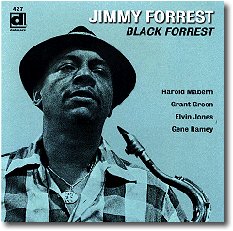 The
following solo is from Grant Green's first recording session. It's an F blues
titled "Dog It",
from Jimmy Forrest's album "Black
Forrest", on the Delmark
label (DD-427). The
following solo is from Grant Green's first recording session. It's an F blues
titled "Dog It",
from Jimmy Forrest's album "Black
Forrest", on the Delmark
label (DD-427).
Recording Date: Chicago, Dec. 10/12 1959
Personnel: Jimmy Forrest (ten sax), Grant Green (gtr), Harold Mabern (p), Gene Ramey (b), Elvin Jones (dr).
Main features of this solo:
1) Use of the F blues scale over both F7 and Bb7.
2) Be-bop phrasing, usually in the second half of the chorus between bars 6-8
and 11-12.
3) Extended use of 8th note triplet rhythms.
4) 16th note triplet embellishments or "trills".
5) Development of short, three-note motives with rhythmic displacement.
6) Arpeggios and diatonic chord extensions.
7) Simple melodic construction contrasted with intricate rhythms, and phrasing
over the bar lines.
Fingering and position markings are just suggestions, but I can offer an
explanation of some choices. Being a blues guitarist at heart, Green favored
fingers 1, 2, and 3 of the left hand, and most intervals of
a minor third, especially in the blues scale, are played with fingers 1 and 3.
Try it this way and you will feel more "power" behind the notes. Some passages
require long (and quick!) stretches, especially where he plays triplets, so you
may feel more comfortable using the 4th finger. It's a good idea to experiment
and decide what works best for you.
The positions indicated are ones that seem logical based on an
interpretation of Green's playing, however there are often other possibilities
that work just as well and still make the phrase sound and feel right - after
all, that's what's important.
For more evidence, there is a video of Grant Green playing with Kenny
Burrell and Barney Kessel, which provides a valuable and rare
opportunity to see how he approached the instrument. 1It's a live recording of a
tune titled "Blue Mist"
at Ronnie Scott's club in London,
1969.
The video is called "Legends of Jazz Guitar, Vol. 2" available through
Music Sales Limited (OV 11320).
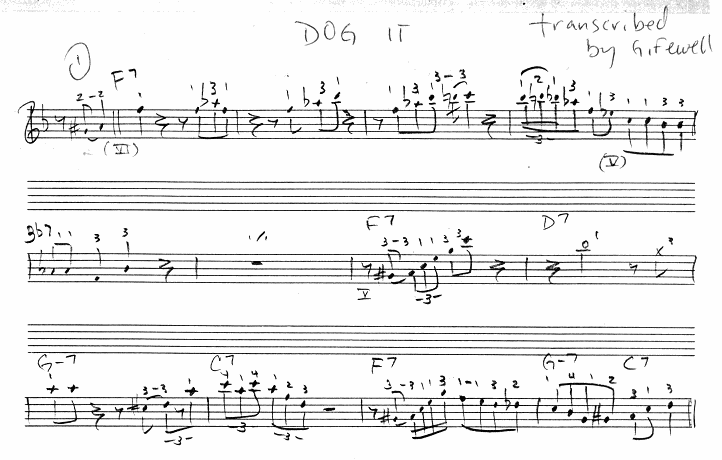
CHORUS 1
In the first two
choruses, he uses all of these techniques. He starts with an F blues scale
(1, b3, 4, b5, 5, b7 = F, Ab, Bb, B, C, Eb), then chooses a short rhythmic
motif of three notes, starting on upbeats for a syncopated feel, and expands it
upwards in bars 1-3, then descends in bars 4-5 with a classic F
blues line. The first beat of bar 4 contains a characteristic figure that
Grant repeats often - a 16th note triplet followed by an eighth note.

Between
bars 5 and 7, he leaves a long pause, (almost 1 & 1/2 measures), and
comes in off the beat with an Amin7 arpeggio, pauses 2 more beats, and
hits the Bb on the second beat of bar 8. This is an example of how
Grant used rests (space) as an integral part of his phrasing. (Some guitarists'
idea of a "rest" is something you do at the end of a very long road tour!).
Bars 9-10
contain the eighth-note triplet figures for which Grant is famous. The notes
spell a Dmin7 arpeggio where the C7 chord should be. The F natural
in the Dmin7 arpeggio is the fourth (or 11th) degree of C7. Blues players will
often play this note on a dominant chord, rather than the "correct" note, which
would be the third degree (E natural on C7). The Dmin triad includes the
diatonic extensions of the C7 chord (D, F, A = 9,
11, & 13 of C7). Of course Grant isn't thinking that way - he just
arpeggiates notes from the F (major) pentatonic scale.

Bars 11-12
are a good example of Charlie Parker's influence. This is a classic be-bop
phrase over the turnaround at the end of a blues and includes the
double-chromatic approach that Parker favored in his lines. From the note Bb in
bar 12, the two notes G and G# create the double chromatic
resolution upward to A on beat three. Grant repeats this phrase in the
second chorus, and a variation in the fourth chorus, but always starting on
different beats in different measures.

CHORUS 2

In bar 1,
Grant hits a C on the first string and moves down chromatically to Ab in
bar 3. But again, it's the rhythm that's interesting here. By playing a
half note (Bb) right in the middle of bar 2, and tying it over the
bar line to a dotted half note (A) in bar 3, he creates another
offbeat rhythmic syncopation, which temporarily changes the pulse.

The
resolution from bars 4 to 5 is important. Grant plays C# at
the end of bar 4, resolving over the bar line to D on the Bb7
chord. This classic blues sound occurs by moving into the third degree of the
chord from a half step below. (the Bb7 third degree is D so the note half
step below is C#).
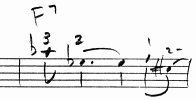 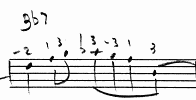
In bar 6,
he quotes the phrase he played at the end of the first chorus, starting this
time on the "and" of the second beat.
Bars 8 - 12 is a perfect example of phrasing over the bar lines, making
them just about disappear. He's so laid back at this point, and I love how the
offbeat triplets in bars 10 and 11 seem to just hang in mid-air, floating over
the rhythm section.
Check back for the next lesson coming soon: The last three choruses of
Grant's solo with analysis and suggested fingerings, and a list of my favorite
recordings he made.
|
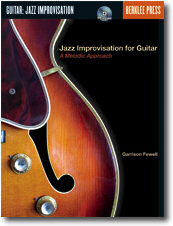
Garrison's new book
Jazz Improvisation
for Guitar – a Melodic Approach
is now available on Berklee Press
and distributed internationally by Hal Leonard
It includes
tablature for guitar and comes complete with a 90+ track cd with back-up
trio tracks for play along exercises by Garrison, bassist Steve LaSpina
(a long time collaborator with guitarist
Jim Hall)
and drummer John Riley.
More articles by Garrison are available online through his website:
www.garrisonfewell.com/pages/LESS.html
You can download Garrison's lessons for Guitar Player magazine directly
from Truefire Music
http://truefire.com/list.html?store=audio_lessons&viewauthor=208
These lessons include tab for guitar and
audio tracks of all the musical examples.
|
Insert a comment
©
2001, 2004 Jazzitalia.net - Garrison Fewell - All rights reserved
|
© 2000 - 2026 All the material published on Jazzitalia is exclusively owned by the author. Moreover it is protected by International Copyright, so it is forbidden any use of it which isn't authorised by the rights' owner.
|
This page has 24.900 hits
Last Modified Date: 27/08/2005

|
|

